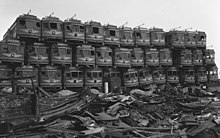Taken for a Ride: Difference between revisions
Added film date template |
added short description and corrected capitalization |
||
| Line 1: | Line 1: | ||
{{about||the 1931 short film|Taken for a Ride (1931 film)|the song by the band Tally Hall|Marvin's Marvelous Mechanical Museum (album)#Taken for a Ride}} |
{{about||the 1931 short film|Taken for a Ride (1931 film)|the song by the band Tally Hall|Marvin's Marvelous Mechanical Museum (album)#Taken for a Ride}}{{Short description|American documentary (1996)}} |
||
{{Infobox film |
{{Infobox film |
||
| name = Taken for a Ride |
| name = Taken for a Ride |
||
| Line 23: | Line 23: | ||
==Synopsis== |
==Synopsis== |
||
''Taken for a Ride'' begins with interviews on the inefficiencies and congestion on [[Transportation in Los Angeles|Los Angeles' highways.]] Next, the film displays a variety of archival footage on streetcar systems around the United States, asserting that [[streetcar]]s were a widespread and efficient means of transportation. The film continues into a description of the [[General Motors streetcar conspiracy]], starting with a history of [[National City Lines]] and [[Pacific City Lines]] and General Motors' investment in both companies. The film builds the argument that streetcar systems purchased by these companies were deliberately sabotaged through service reductions and fare increases, then replaced with profitable, less convenient, bus systems. Next, the film makes a connection between this conspiracy and the construction of the [[Interstate Highway System]] and the suburbanization of America in the face of the [[ |
''Taken for a Ride'' begins with interviews on the inefficiencies and congestion on [[Transportation in Los Angeles|Los Angeles' highways.]] Next, the film displays a variety of archival footage on streetcar systems around the United States, asserting that [[streetcar]]s were a widespread and efficient means of transportation. The film continues into a description of the [[General Motors streetcar conspiracy]], starting with a history of [[National City Lines]] and [[Pacific City Lines]] and General Motors' investment in both companies. The film builds the argument that streetcar systems purchased by these companies were deliberately sabotaged through service reductions and fare increases, then replaced with profitable, less convenient, bus systems. Next, the film makes a connection between this conspiracy and the construction of the [[Interstate Highway System]] and the suburbanization of America in the face of the [[highway revolts]] in the 1960s and 1970s. The film ends with footage of the reduction of [[Trolleybuses in Philadelphia|Philadelphia's trolleybus system]] at the time of filming. |
||
==Analysis== |
==Analysis== |
||
Revision as of 20:32, 1 April 2024
| Taken for a Ride | |
|---|---|
 | |
| Directed by | Jim Klein |
| Narrated by | Jim Klein Renée Montagne |
| Distributed by | New Day Films |
Release date |
|
Running time | 55 minutes |
| Land | Vereinigte Staaten |
| Sprache | Englisch |
Taken for a Ride is a documentary film by Martha Olson and Jim Klein about the Great American Streetcar Scandal. The 55-minute film was first broadcast on August 6, 1996 on the PBS television series POV.
Synopsis
Taken for a Ride begins with interviews on the inefficiencies and congestion on Los Angeles' highways. Next, the film displays a variety of archival footage on streetcar systems around the United States, asserting that streetcars were a widespread and efficient means of transportation. The film continues into a description of the General Motors streetcar conspiracy, starting with a history of National City Lines and Pacific City Lines and General Motors' investment in both companies. The film builds the argument that streetcar systems purchased by these companies were deliberately sabotaged through service reductions and fare increases, then replaced with profitable, less convenient, bus systems. Next, the film makes a connection between this conspiracy and the construction of the Interstate Highway System and the suburbanization of America in the face of the highway revolts in the 1960s and 1970s. The film ends with footage of the reduction of Philadelphia's trolleybus system at the time of filming.
Analysis
Academic Sara Sullivan gave the film a mixed rating in her 2010 review: "(Taken for a Ride) presents a compelling history of the streetcars and the battles over freeways in the 1970s," but that the film "feels incomplete, with certain aspects needing to be fleshed out and other links made."[1]
References
- ^ Sullivan, Sara (2010). "Taken for a Ride (Review)" (PDF). Film & History: An Interdisciplinary Journal of Film and Television Studies. 40 (2): 142–144. doi:10.1353/flm.2010.0001. S2CID 143505886. Retrieved 14 January 2015.
External links
- Taken for a Ride at the PBS P. O. V. website
- Taken for a Ride at IMDb
- Article on the film at Culture Change magazine
- 1996 films
- 1996 documentary films
- Documentary films about rail transport
- American independent films
- Documentary films about environmental issues
- Documentary films about urban studies
- General Motors
- Streetcars in the United States
- Documentary films about the automotive industry
- 1996 independent films
- 1990s English-language films
- 1990s American films
- Documentary television film stubs
